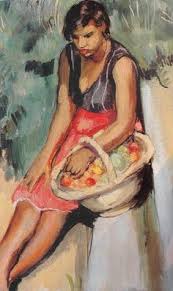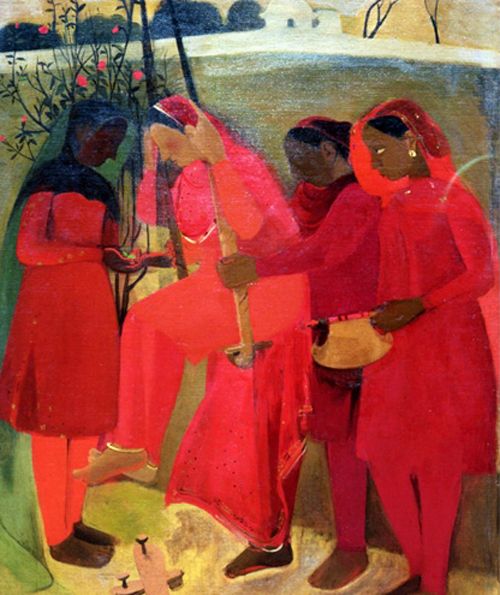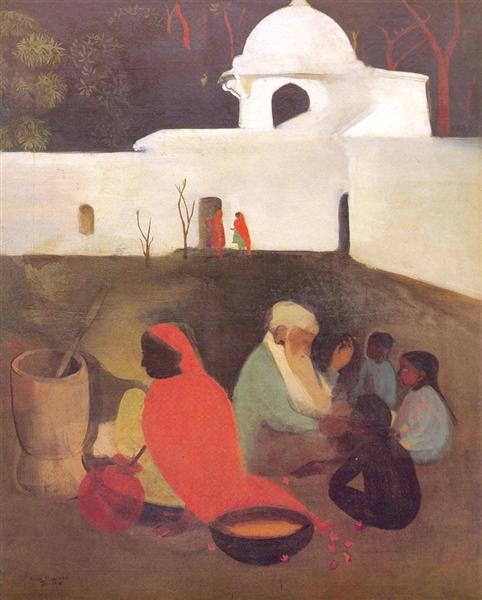
Amrita an enigma – 2
 By Amit Srivastava
By Amit Srivastava
Amrita Sher-Gil remains not only one of the most enigmatic artists of the modern era, but her legacy continues to grow with the passage of time. She is definitely the most celebrated female artist of modern India. Born of Hungarian –Indian parents, she is variously called ‘”one of the greatest avant-garde women artists of the early 20th century” and India’s ‘Frida Kahlo’.
Also read: Feature: Amrita is an enigma even now
Amrita was beautiful and extremely gifted and led life on her own terms. She died in 1941 when she was just 28 years of age but she has left behind such a body of work that her legend continues to grow. She became an eloquent symbol of the fusion between the east and the west. Her charismatic and many sided life story is as important as her paintings as they are closely intertwined. According to her biographer Yashodhara Dalmia “the discussions of her paintings follow the trajectory of her own life and correspond with her own development “ ….
She used to write extensively to her friends and well-wishers. These letters are a great window to the minds of this brilliant artist. They also form a great primary source for studying her evolution as an artist, and the high standards she set for her art and her struggles to evolve constantly.
Amrita was a bright child and had a and had a fascination and skill in sketching and painting from an early age. As a kid one of her earliest tutor was the artist Hal Bevan Perman in Shimla. He believed Amrita was an unusual talent and could become a great artist if given freedom to pursue her choice .
She has mentioned in her diary about the marriage of a child bride where she was deeply affected by the sadness and hopelessness of the child bride. Although she belonged to an aristocratic family her sensitive character could not stay untouched by plight of poor masses of India. The deep empathy she felt for Indian women and their hard struggle against the social norms of the time would express itself through undercurrents, again and again in her paintings. The melancholic aspect of her life is reflected in many water colours and paintings of this period. In 1927, the well- known Hungarian Indologist, Historian and an artist Erwin Baktay, who was also her uncle, paid her family a visit. He introduced her to the Nagybanya School of painting to which he belonged. This school was one of the major influences on Hungarian artists for a long time. In fact he was the one who requested Amrita’s parents to take her to Paris which could do justice to her talent. She is on record saying that she owed her kills in drawing to him.
One of the most important early influences that shaped her work came from her stay in Paris for 5 years. She reached Paris when she was just a girl of sixteen years. Her art flourished at the prestigious Ecole des Beaux where she was admitted in spite of being underage. The institute was headed by Professor Lucien Simon. Amrita later acknowledged the contribution of her Professor in shaping her in the right direction. Amrita has mentioned in her diaries that he never really taught but he made the students think for themselves and solve technical and pictorial problems themselves.
 Paris at that time was the cultural center of the world and Amrita greatly benefitted from its liberalized atmosphere. Paris was a place for constant innovation and experiments with individualism. In this creative and liberal atmosphere, she did several noteworthy paintings and portraits. She is said to have drawn inspiration mainly from Cezanne, Gauguin and Van Gogh. It is possible that she may have been influenced by Picasso also. Amrita was greatly affected by the works of Cézanne, a Post-Impressionist painter whose style is visible in many of her paintings. She used a professional model for several of her paintings. Her portrayal of the model might have been influenced by Picasso in slightly elongated form. Among the noteworthy paintings during this period mention may be made of The Professional Model, Young Girls. Her portrait of fellow artist Boris Tasiltzky ( ‘ The Man with Apples’), is also well known. During this period she made hundreds of sketches mainly in charcoal of male and female nudes. She also started to paint in oil during this time.
Paris at that time was the cultural center of the world and Amrita greatly benefitted from its liberalized atmosphere. Paris was a place for constant innovation and experiments with individualism. In this creative and liberal atmosphere, she did several noteworthy paintings and portraits. She is said to have drawn inspiration mainly from Cezanne, Gauguin and Van Gogh. It is possible that she may have been influenced by Picasso also. Amrita was greatly affected by the works of Cézanne, a Post-Impressionist painter whose style is visible in many of her paintings. She used a professional model for several of her paintings. Her portrayal of the model might have been influenced by Picasso in slightly elongated form. Among the noteworthy paintings during this period mention may be made of The Professional Model, Young Girls. Her portrait of fellow artist Boris Tasiltzky ( ‘ The Man with Apples’), is also well known. During this period she made hundreds of sketches mainly in charcoal of male and female nudes. She also started to paint in oil during this time.
During the summer holidays, she used to visit Hungary. The paintings done in Hungary were Children on Zebegeny Hillside, Girl in Fields, Gypsy Girl from Zebegeny.
By the year 1933 she had an intense desire to go back India and to her roots.. She had a strong inner calling that her future lay in India. She was restless during this period This was a restlessness where she was searching for her roots, her identity as an artist. She says, “My professor had often said , judging by the richness of my colouring, I was not really in my element in the grey studios of the West, that my true artistic personality would find its true atmosphere in the colour and light of the East.”
In India, she was impressed with Rabindranath’s style of drawing. She is on record saying that she liked his paintings even better that his poetry. It is strongly believed that her art was strongly influenced by the two leading doyens of Bengal school of painting – Rabindranath and Abanindranath. Her portraits of women could have been influenced by Rabindranath’s works while the use of ‘chiaroscuro’ and bright colors reflect the influence of Abanindranath.

India, with its artistically rich historical monuments, diversity of people and bright colours was vast treasure for Amrita to draw inspiration from. Her visit to the Ajanta caves was an absolute revelation for her soul. She was awestruck with the richness, sensuality and lyricism of the cave paintings. She didn’t fail to notice the mesmerizing wraparound quality of the paintings that seemed to loom towards the viewer. She made several small drawings at Ajanta and Ellora that would influence her paintings later on in a significant way. In a letter she exclaims” I don’t think I have ever seen anything that can equal it. Simply extraordinary”.

Amrita had closely studied Rajput and Mughal miniatures and was captivated by their lyricism. Some of the paintings she did in Saraya, their ancestral place, displays a strong influence of Rajput miniatures. ‘The Ancient Story Teller’ is a strong example in this regard. The painting evoked the stillness and peace of rural life along with its intimate simplicity. Another painting done during this period that resembled Rajput miniature was ‘The Swing’. This is a painting in deep red and greens, in which a young woman swings very often seen in Rajput miniatures.
Although some of her work had Rajput miniatures she was really keen to learn assimilate the subtlety of the Mughal miniatures. She writes ‘”The Moghuls have taught me a lot. Looked at rightly, the Moghul portraits can teach one everything that matters – subtle yet keenness of form acute and somewhat detached ironical observation”. Her study of Moghul art helped her a great deal refining her own art especially with regard to linking form to context, the intimacy of the figure and the emotive body language. The masterpiece ‘Woman on a Charpoy’ , that was done during her last days, is a strong testimony to the fact that her efforts to achieving the same effect had succeeded. She shows the great economy of line in expressing the emotive state of the protagonist.
(To continue)





